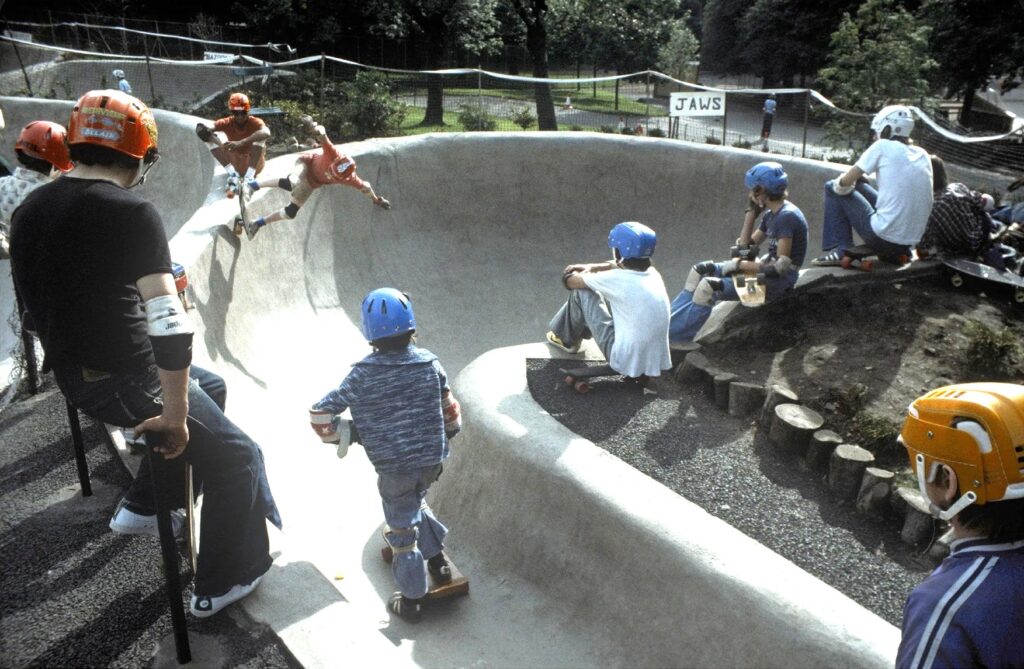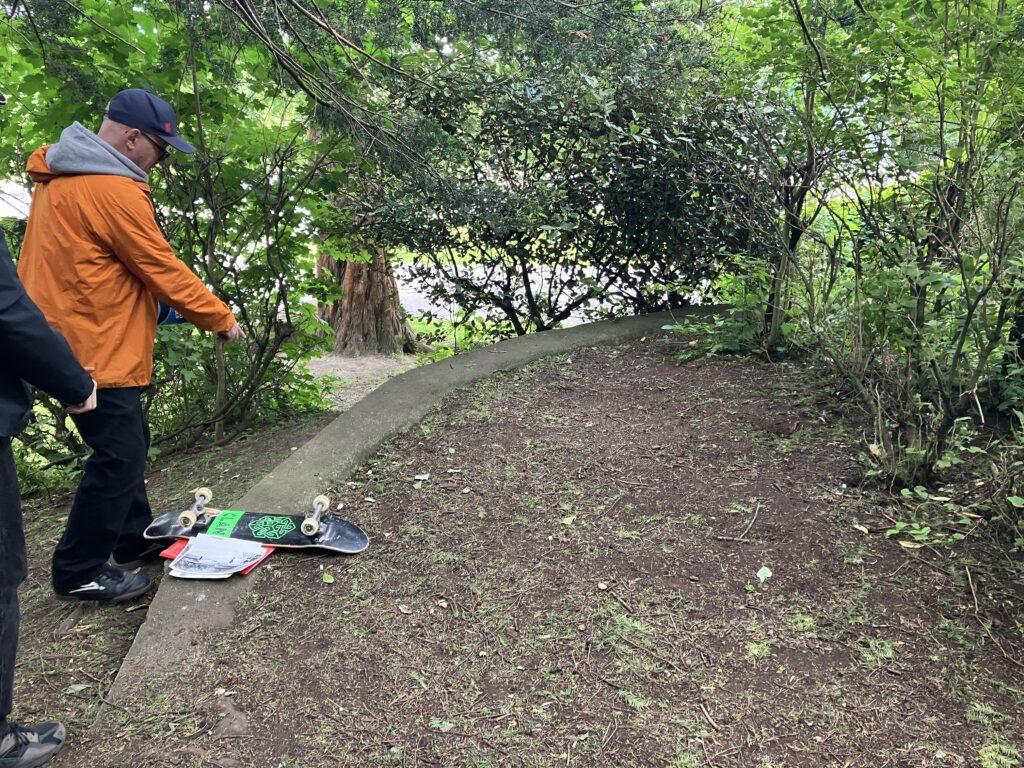News | Posted August 20, 2025
Society Funds Excavation of Scotland’s First Skatepark and More With Latest Grants

The archaeological fieldwork will help to preserve the legacy of Scotland’s first skatepark, with opportunities for the public to get involved.
As part of a broader program of research into the site, the £1,102 grant from the Society will enable experts at the University of Glasgow working with volunteers and students to undertake excavation and survey work at the site of the former Kelvin Wheelies skatepark in Kelvingrove Park.
From 25 to 29 August 2025, the team hopes to learn more about the current condition of the skatepark and ensure that “a central part of modern Glasgow’s sporting heritage” is recorded.
The public are invited to contact the project to share memories, video and photographs of the original Kelvin Wheelies, which will form part of an online archive for the skatepark and help with future fieldwork. The team also encourage visitors to the excavation on the site from 25 to 29 August where they will learn more about the project. To share memories, please contact kenny.brophy@glasgow.ac.uk or use #KelvinWheelies when posting on X and Bluesky.
The state-of-the-art skatepark opened in May 1978 with bowls, a slalom run and a half-pipe (or “hauf-pipe”) and was initially hugely popular. It hosted several competitions, including the first national skateboarding competition in Scotland, the 1978 Scottish Skateboard Championships, where Glasgow dominated the Bowl Riding competitions.

Supported by the Society and coordinated by experts at the University of Glasgow, archaeologists will call on the public to help preserve “a central part of modern Glasgow’s sporting heritage” (© Dr Kenny Brophy FSAScot)
However, growing concerns about maintenance costs and safety led to the park’s closure then burial by 1983. Elements of the original site remain visible adjacent to the modern skatepark in Kelvingrove Park today, but there is currently no information available to explain the significance of this site to Kelvingrove Park visitors, or users of the modern skatepark.
Archaeologists at the University of Glasgow have also partnered with Archaeology Scotland’s New Audiences programme to invite volunteers from asylum seeking and refugee communities to participate in the fieldwork, to continue the programme’s efforts engaging marginalised communities in uncovering Glasgow’s sporting heritage.
Jamie Blair, owner of Glasgow-based skateboarding shop Clan Skates, former member of the Kelvingrove skateboard team and former Scottish skateboard champion, said:
“When Kelvin Wheelies opened in 1978, skaters from all over the UK flocked to this radical new facility. A park team was formed and for the next few years Glasgow was the dominant force in Scottish skateboarding. Sadly, a dip in skateboarding’s popularity in the early 1980s and the construction of a rival skatepark in Livingston saw the decline of Kelvin Wheelies, with the main bowlriding area buried in time. I’m thrilled that through this project we have a chance to rediscover it.”

The upcoming survey and excavation of Kelvin Wheelies skatepark funded by the Society will reveal long-buried features used in the 1978 Scottish Skateboard Championships (© Dr Kenny Brophy FSAScot)
Dr Kenny Brophy FSAScot, Senior Lecturer in Archaeology at the University of Glasgow and project leader, said:
“There is a very real danger that this skatepark, a place that was so special for hundreds of young people just decades ago, will become forgotten and lost. Contemporary archaeology allows us the opportunity to explore even fairly recent events and places to jog memories, combining traditional archaeological fieldwork techniques with interviews and documentary research.
In the case of Kelvin Wheelies, this is a unique opportunity for a generation of skateboarders to relive the excitement of their youth and excavate their own memories of a place that was so special to them.”
The Society supports high-quality research and publication relating to Scotland’s past by making several grants and awards twice each year. This round awarded a total of £17,478 to 11 projects researching an aspect of Scottish history or archaeology:
- Digging the Kelvin Wheelies: exploring Glasgow’s skatepark heritage – survey and excavation to assess the extent, and current state of repair, of the 1978 Kelvin Wheelies skatepark including buried features
- Ulva Forest Project: A walkover survey and dendrochronological appraisal – a specialist survey to identify sites of archaeological and dendrochronological interest on the Isle of Ulva
- Scottish Archaeological Forum Conference – a two-day hybrid conference entitled ‘Building Bridges: Connecting Scotland’s Archaeological Community’, organised by postgraduate researchers and early-career archaeologists from the Universities of Glasgow, Edinburgh, and St Andrews
- Non-invasive dendrochronology (DendroCT) of two viking Ship stems from Eigg – investigating two Viking boat stems, currently broadly dated 885 – 1035 AD, found on the Isle of Eigg, to more accurately determine their dating and discover the region where these trees grew
- Leith Giles Street – bringing to publication in Scottish Archaeological Internet Reports (SAIR) a significant urban archaeological site in Edinburgh
- Re-evaluating Orkney’s runic inscriptions – a re-evaluation and updated analysis of the runic inscriptions of Orkney
- Organised Female Emigration from Shetland and Skye to Australia during the Great Famine – research of archival materials related to famine management on the islands of Skye and Shetland to determine how the crisis was addressed and the extent to which female emigration was considered as a solution
- Scottish Tea Merchants and the Global Interactions in China’s Modern Transformation: A Microhistory Based on William Melrose’s Correspondence (1845–1855) – archival research investigating the role of Scottish tea merchants in shaping global trade and local transformation in nineteenth-century China
- Investigating the Past: Excavations at Black Hill, Lesmahagow and Castle Qua, Lanark – commissioning archaeological illustrations of fragments of prehistoric pottery, a shale bangle and two small beads found during excavations of an Iron Age site in Lanark
- Rannoch Moor Excavation – excavation investigating how a landscape in northern Scotland was shaped and reshaped by human interactions with the environment, and how the management of diverse subsistence, fuel and industrial practices changed over the later medieval and early modern periods
- Findhorn Dunes Site Project – a project to recover fragmentary remains of a multi-period site in the sand dunes on the Moray coast. Sand dune environments are rare in the UK, and indeed Europe, and this site represents an opportunity to further understand how these areas were occupied and exploited in prehistory
You can read about many of our past Society funded research projects here.
Dr Helen Spencer FSAScot, Head of Research at the Society of Antiquaries of Scotland, said:
“As a charity, we are especially grateful to our thousands of Fellows across the globe, whose subscription fees enable us to distribute these grants each year. If you’d also like to support our work, please consider becoming a Fellow to help cover the cost of high-quality research into Scotland’s past.”
Anyone who is interested in Scotland’s history and archaeology is welcome to apply for Fellowship of the Society, and the next deadline for applications is 30 September 2025. Society grants are also open to everyone, and the next deadline is 30 November 2025.
Header Image: The ‘Jaws’ bowl at Kelvin Wheelies skatepark (Iain Urquhart with kind permission from North Skateboard magazine)
